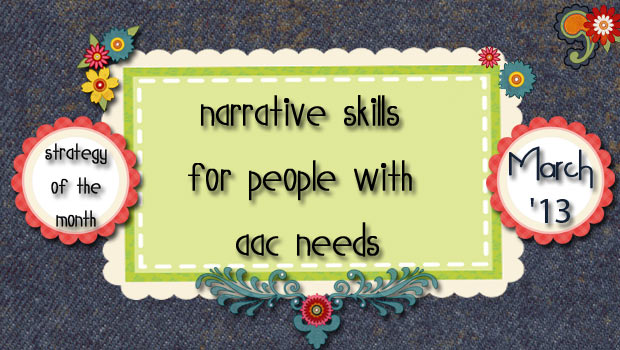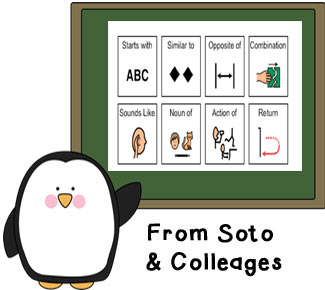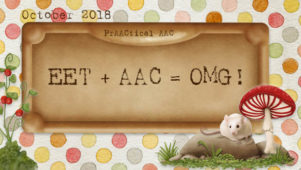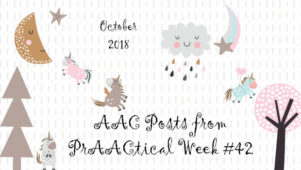Narrative Skills for People With AAC Needs

This month, we’ll share some thoughts about helping people with AAC needs develop narrative skills. Why narrative skills? Because they help us connect to one another and communication learning works best when we feel connected. Among other things, storytelling helps us relate to one another. Narrative language is important for reading and writing skills to develop. It helps us understand the world and ourselves. In telling our stories, we establish our identities. Plus, it’s part of what makes life fun.
In the US, pediatric therapists are having lots of conversations about the Common Core State Standards (CCSS) in English Language Arts (ELA), and how they relate to the IEP goals of the students that they serve. Many of the goals in the ELA speaking domain require students to be able to summarize what they hear and read, so it is no surprise that SLPs are prioritizing narrative language and related skills for their students with language difficulties. How is that translating to kids who use AAC? We’re not sure.
So, in this post, we’ll try to make a case for why narrative language, which often overlooked in intervention with people who use AAC, should get more attention. One reason that SLPs may fail to focus on narratives in students with AAC needs relates to relevancy. We sometimes think of narrative language as less important than things like requesting or commenting. In schools, we sometimes think more about fictional narratives and retelling than other kinds of narratives. Maybe we see those as less meaningful to our students who are learning to use AAC.
We think it’s time to give that a second look. Here are some conversations we overheard in which narratives played a big role.
- A teenager telling her friend the plot line from a TV show that she missed
- A girl telling her dad about something that happened and why she’s in so much pain
- A cashier telling her supervisor why the customer was so irate
- A college student summarizing a passage from an economics textbook
- A kindergarten student telling the class about her geode at sharing time
- A man telling his buddy about a crash at the speedway
- A child telling his mom about his day in school
Relevant? We think so. SLPs frequently use fictional narratives in their therapeutic work with children who have language difficulties. But that usually isn’t the best place to start. The first narrative skills to develop are personal narratives – telling the stories of what happens to us in our day to day lives. That’s a great place to start with kids who use AAC.
“But my kid can’t even put together good sentences. Isn’t it premature to work on narrative skills?”
Nope. It’s not. We think narrative skills are for everyone. Not in the same way, not with the same depth, and not with the same sense of urgency. But everyone can begin developing those skills, even if they have not yet mastered the component skills in semantics and syntax.
We have two things going for us in this venture. One is that narrative skills can be co-constructed. The work of Gloria Soto and her colleagues shows us that we don’t have to rely on the leaner creating the narrative independently at first. Instead, we can use scaffolding. We can support them through the materials we choose and our own comments and questions. Soto’s line of work is showing us that we help these kids build their ability to tell their own stories. We’ve referenced a few of her studies below so that you can get more details.
The second thing that works to our advantage is technology. With AAC technology, we can save narratives that were developed in a co-constructed fashion (i.e., child and adult together) for later retelling using their SGDs, AAC apps, or communication boards/books. For some AAC learners, we may choose to flesh out the narrative using complete, well-constructed sentences.

Here’s an example: Dana is an SLP working with Jason, a preschool child with autism who uses a picture schedule, several shared classroom communication devices, a communication book, and a mobile device with an AAC app. Jason is developing early communication skills, and has IEP goals for choicemaking, asking for help, and following directions.
Let’s consider some excerpts for how Dana approached narrative development in her session. Most days, the teacher uses a notebook like this one or this one that goes back and forth from home to school to report about the school day. On the days that Dana is in the classroom, they also record some messages into his AAC app. In her session, Dana uses many different supports so that Jason can help co-construct the narrative. Once they’ve constructed the narrative together, she records it into his iDevice so that he can share it with his family. Here are some short excerpts from their session.
“Jason, let’s get ready to tell your mom about school today. Let’s get your schedule to help us.” She pauses to let Jason get his schedule and guides him to do so when he fails to respond. “What should we tell her about?” Jason picks the circle time picture from his schedule. “Yes, we can tell her about circle. You can tell her about the song.” Gives him a choice board used in circle to pick the songs, and Jason picks one. “Wheels on the Bus. We can tell her about singing that at circle.” “What else should we tell her?” Jason picks free play, and Dana offers him the choice board from the free play area of the classroom and pauses while he picks one. “Legos.” “We can tell her who you played with, too.” Dana helps Jason navigate to the page with his classmates names and pictures, and supports him in responding. “Let’s tell her about one more thing.” Jason picks ‘recess’ and Dana helps him use his iDevice to tell what he did and who he played with. At the end, she helps him navigate to the feelings vocabulary so that Jason could talk about how he felt about his day. Dana then goes to an My Day at School screen in his device to record a full narrative based on what Jason has told her during this activity.
Is he independent? No. But he’s learning. And by stretching Jason’s communication from choicemaking/requesting to co-constructing narratives, she is helping him develop the foundation for future skill growth.
Throughout the month, we’ll talk more about narrative skills in AAC learners. We’ll share some ideas for assessment, intervention, tools, and activities. Certainly the kinds of narrative we work on and the way in which those narratives are expressed vary widely from learner to learner, but ideas of how different clinicians approach this can inspire us all. Do you teach narrative language in your AAC work? Please share your thoughts and experiences so that we can all benefit.
Selected References
Solomon-Rice, P.L. & Soto, G. (2011). Co-construction as a facilitative factor in supporting the personal narratives of children who use AAC. Communication Disorders Quarterly, 32, 70-82.
Soto, G., Solomon-Rice, P. & Caputo, M. (2009). Enhancing the personal narrative skills of elementary school-aged students who use AAC:” The effectiveness of personal narrative intervention. Journal of Communication Disorders, 42, 43-57.
Soto, G., Yu, B., & Kelso, J. (2008). Effectiveness of multifaceted narrative intervention on the stories told by a 12 year old girl who uses AAC. Augmentative and Alternative Communication, 24, 76-87.
Soto, G., Yu, B., Henneberry, S. (2007). Supporting the development of narrative skills of an 8 year-old child who uses an augmentative and alternative communication device: Case Study. Child Language Teaching and Therapy, 23, 27-45.
Filed under: Strategy of the Month
Tagged With: langage development, narrative language, storytelling, strategy
This post was written by Carole Zangari





9 Comments
Great post – and I love the really practical suggestion for using the communication books between home and school for developing narrative skills. Thanks 🙂
Thanks, Jane! For some classrooms, this is just a different way to frame something that they do every day. It’s interesting how making a slighht tweak can sometimes make a big difference.
Excellent post! I love the ideas and practical uses! I’ll be sharing with many people!
Thanks so much, Patrick! Would love any/all feedback about what others are doing to build narrative language skills.
I’ve been having my students make stories on TarHeelReader.org and use picture supports to make stories. I especially like to do stories about activities that we’ve done together as a class!
That’s such a great idea! If you ever do a narrative like this based on a TarHeel Reader book that you and your students would like to share, let us know. We can post about it to help others move forwawrd in implementing this. I love things like this that link different goals together. If it makes so much sense to US, then surely it will help the kids connect the dots and develop functional skills that benefit them in their day to day lives. Thanks for sharing this, Patrick!
You are welcome to use any of the stories we have written, just head to http://tarheelreader.org and search for “SOAR” and you will find all of the books we’ve written!
Thank you so much!
http://mattramzzz.wordpress.com/about/writing-tutoring/
Please find the URL, above; it is my narrative account of how it is that I have been able to rebound, following my final and most voluminous avm-stroke.